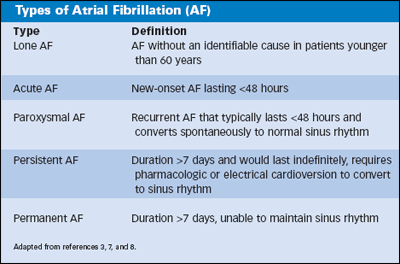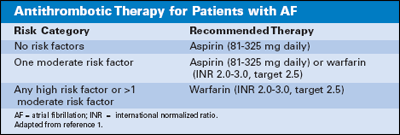Article
Aggressive AF Treatment Reduces Stroke Incidence-January 2008
Author(s):
New guidelines for managing patients with atrial fibrillation emphasize stroke prevention.
Ms. Terrie is a clinical pharmacy writer based in Haymarket, Virginia.
Atrial fibrillation (AF) is the most prevalent type of arrhythmia in clinical practice and can present without symptoms. AF accounts for an estimated 33% of hospitalizations due to cardiac rhythm disturbances.1 The rate of AF occurrence has increased significantly over the past 20 years.1 Two and a half million individuals in the United States are affected by the condition.1,2 The incidence of AF increases with age; recent statistics indicate that AF affects an estimated 5% of patients older than 69 years and 8% to 10% of those older than 80 years.2-4 In addition, AF appears to occur more frequently in men than women.2-4
Types of AF are defined in Table 1. According to the American Heart Association (AHA), approximately 15% to 25% of strokes occur in patients with AF, and approximately half of the elderly with AF have hypertension.1,2,4,5 A 20% to 40% risk of postoperative incidence of AF is associated with patients who have undergone cardiac, pulmonary, or esophageal surgery.1 AF also can cause 5% to 10% of acute myocardial infarctions.2
Risk factors of AF include advanced age, male gender, uncontrolled hypertension, valvular heart disease, coronary artery disease, ventricular hypertrophy, pericarditis, diabetes, hyperthyroidism, certain pulmonary disorders, and a history of smoking.2,3,6 The 2 major complications linked with AF are AF-associated stroke and heart failure.6 Other complications include arterial embolization, severe bradycardia, and rate-related myocardial ischemia.3 Although AF can be asymptomatic, patients may experience various symptoms including dizziness, palpitations, dyspnea, fatigue, syncope, weakness, and angina.2,3,8
Table 1

Treatment
In August 2006, revisions to the 2001 AF guidelines were published by the American College of Cardiology, the AHA, and the European Society of Cardiology in a report entitled Guidelines for the Management of Patients with Atrial Fibrillation. These guidelines reflect results from recently published clinical trials. They state that the use of pharmacologic agents and ablation are effective for both rate and rhythm control.1 In addition, surgery may be the favored choice under certain circumstances.1 Regardless of the treatment approach, the need for anticoagulation therapy is based on stroke risk, not on whether sinus rhythm is maintained.1 The new guidelines place strong emphasis on stroke prevention and also state that controlling cardiac rate is equally effective to controlling cardiac rhythm.1,4 Also, results from several studies support the conclusion that heart-rate control is better tolerated and may have better results in certain patients.4
The therapy goals in treating AF include maintaining sinus rhythm, preventing thromboembolism, and correcting the rhythm disturbance.1,2 According to the guidelines, several factors should be considered when establishing a plan to manage AF1:
- Type and duration of AF
- Severity and type of symptoms
- Other possible cardiovascular diseases
- The patient’s age
- Other preexisting medical conditions
- Short- and long-term treatment goals
- Pharmacologic and nonpharmacologic therapeutic options
Heart-rate Control
According to the new guidelines, rate control may be considered as an initial therapy for older patients with persistent AF who have hypertension or cardiovascular disease, based on the degree of patient symptoms.1 The pharmacologic agents used for treating AF can be classified into 2 general classes: rate controlling and rhythm restoring.2 Beta-blockers and calcium channel blockers are the drugs of choice for rate control.2
The use of pharmacologic agents such as beta-blockers and nondihydropyridine calcium channel blockers are recommended in most cases for patients with persistent or permanent AF, according to the new guidelines.1 In patients without ventricular pre-excitation, the use of intravenous beta-blockers (eg, esmolol, metoprolol, propranolol) or nondihydropyridine calcium channel antagonists (eg, verapamil, diltiazem) is recommended to slow the ventricular response to AF in the acute setting; caution should be used in patients with hypotension or heart failure.1,3,8 Beta-blockers initially should be used with caution in patients with AF and heart failure who have reduced ejection fraction.1 The major adverse effects associated with the use of esmolol and other beta-blockers include hypotension and bronchospasm.1 Caution should be used in individuals with heart failure because of the negative inotropic effects associated with the nondihydropine calcium channel blockers, which may cause hypotension.1 The long-term use of calcium channel blockers may be a more favorable drug of choice over beta-blockers in patients with bronchospasm or chronic obstructive pulmonary disease.1-3 In some cases, the administration of digoxin or amiodarone intravenously also is recommended to control the heart rate in patients with AF and heart failure who do not have an accessory pathway.1
Digoxin is no longer considered a first-line therapy for rapid management of AF, except in patients with heart failure or left ventricle dysfunction, because of the various other effective pharmacologic agents available.1 Results from the Atrial Fibrillation Followup Investigation of Rhythm Management study showed that with or without digoxin, the use of beta-blockers were the most effective drug class for rate control, achieving the specified heart rate end points in 70% of patients, compared with 54% with the use of calcium channel blockers.1
In some cases of AF, the use of a combination of pharmacologic agents may be necessary to achieve adequate rate control, but clinicians should use caution to avoid incidences of bradycardia.1 Catheter ablation should be considered in some cases to sustain sinus rhythm in patients who did not respond to antiarrhythmic agents.1
Table 2

Rhythm Control
In general, the use of pharmacologic agents for rhythm control is the first choice for therapy. Left atrial ablation is a second-line choice, particularly in patients with symptomatic lone AF.1 The administration of flecainide, dofetilide, propafenone, or ibutilide is recommended for pharmacologic cardioversion of AF, and a reasonable option is the use of amiodarone.1 The administration of quinidine or procainamide may be considered for pharmacologic cardioversion of AF, but the effectiveness of these agents is not confirmed.1 The guidelines also state that digoxin and sotalol may be considered harmful when used for pharmacologic cardioversion of AF and are not recommended.1 In addition, the use of quinidine, procainamide, disopyramide, and dofetilide should not be initiated out of a hospital setting for the conversion of AF to sinus rhythm.1
Stroke Prevention
The AHA recommends aggressive treatment of AF because effective treatment is beneficial in reducing the incidence of stroke.6 The long-term use of warfarin in patients with AF and other risk factors associated with stroke may reduce the risk of a stroke by as much as 68%.6 With regard to antithrombotic therapy for individuals with AF, the new guidelines outline recommendations in 3 categories (Table 2).
In addition to pharmacologic therapy, a variety of nonpharmacologic therapies may be appropriate for some patients and considered to maintain sinus rhythm in selected patients who failed to respond to or are unable to tolerate antiarrhythmic drug therapy. Examples include left atrial ablation, the maze operation, atrioventricular nodal ablation, and pacing.1
Additional Preventive Care
Although not extensively studied, the use of statins has been suggested to protect against AF, and dietary lipid components may be beneficial to those with a predisposition to AF.1 Results from a study published in the August 2007 issue of the American Journal of Cardiology report that individuals taking statins were significantly less likely to have new-onset AF.9
For more in-depth information on the 2006 ACC/AHA/ESC Guidelines for the Management of Patients with Atrial Fibrillation, please visit circ.ahajournals.org.
Results from experimental and clinical studies also have shown that the use of angiotensin-converting enzyme (ACE) inhibitors and angiotensin receptor antagonists may decrease the incidence of AF.1 These studies have demonstrated that in patients with AF, the use of agents such as ACE inhibitors may decrease atrial pressure, decrease the frequency of atrial premature beats, reduce fibrosis, and decrease the relapse rate after cardioversion.1
References
- ACC/AHA/ESC 2006 Guidelines for the Management of Patients with Atrial Fibrillation. American Heart Association. Circulation. 2006;114:e257-e354. circ.ahajournals.org/cgi/content/full/114/7/e257. Accessed December 12, 2007.
- Rosenthal L. Atrial Fibrillation. EMedicine. www.emedicine.com/med/topic184.htm. Accessed December 12, 2007.
- Lazar J, Clark AD. Atrial Fibrillation. EMedicine. www.emedicine.com/emerg/topic46.htm. Accessed December 12, 2007.
- Atrial Fibrillation. Drug Digest. www.drugdigest.org/DD/HC/Treatment/0,4047,971,00.html. Accessed December 12, 2007.
- Guidelines for Prevention of Stroke in Patients with Ischemic Stroke or Transient Ischemic Attack. American Heart Association. Stroke. 2006;37:577-617. stroke.ahajournals.org/cgi/content/full/37/2/577. Accessed December 12, 2007.
- Atrial Fibrillation. American Heart Association. www.americanheart.org/presenter.jhtml?identifier=4451. Accessed December 12, 2007.
- Reddy, V. The Clinical Implications of Current Treatment Approaches, Including Ablation, for Atrial Fibrillation. Medscape. www.medscape.com/viewarticle/497332. Accessed November 14, 2007.
- Cardiovascular Disorders. In: Beers MH, Porter RS, eds. The Merck Manual of Diagnosis and Therapy. 18th ed. 2006:696-699.
- Statins Linked to Reduced Prevalence of Atrial Fibrillation in Patients with ACS. Medscape. www.medscape.com/viewarticle/562804. Accessed November 14, 2007.





